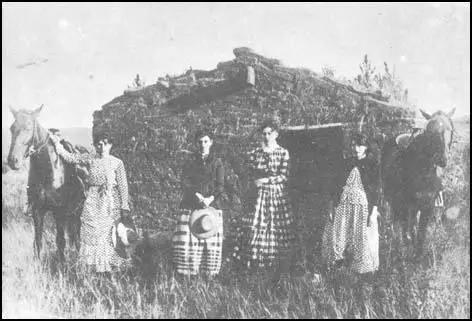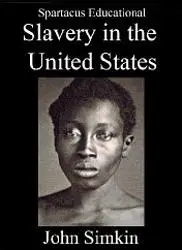Kansas-Nebraska Act
Kansas and Nebraska were important areas for growing wheat, corn, oats and rye and were therefore popular places for migrants from the eastern areas of American to settle. In 1854 Stephen A. Douglas introduced his Kansas-Nebraska bill to the Senate. These states could now enter the Union with or without slavery. Frederick Douglass warned that the bill was "an open invitation to a fierce and bitter strife".
The result of this legislation was to open the territory to organised migrations of pro-slave and anti-slave groups. Southerners now entered the area with their slaves while active members of the Anti-Slavery Society also arrived. Henry Ward Beecher, condemned the bill from his pulpit and helped to raise funds to supply weapons to those willing to oppose slavery in these territories. These rifles became known as Beecher's Bibles. John Brown and five of his sons, were some of the volunteers who headed for Kansas.
Kansas elected its first legislature in March, 1855. Although less than 2,000 people were qualified to take part in these elections, over 6,000 people voted. These were mainly Missouri slave-owners who had crossed the border to make sure pro-slavery candidates were elected. The new legislature passed laws that imposed the death penalty for anyone helping a slave to escape and two years in jail for possessing abolitionist literature.

In January 1861 Kansas entered the Union as a Free State. During the American Civil War Kansas provided 20,000 soldiers from the Union Army. This made it a target and on 21st August 1863, the Quantrill Raiders raided the town of Lawrence. attacked the town of Lawrence. During the raid Quantrill's gang killed 150 inhabitants and destroyed over 180 buildings.
After the American Civil War there was a great demand for meat in the northern and eastern parts of the United States. It is estimated that at this time there were over 5 million Longhorns in Texas. Between 1866 to 1895 some 10 million cattle were taken to the railroad cowtowns. The main route from Texas to Kansas was the Chisum Trial and the Goodnight Trail. The task of the cowboy was to take part in cattle drives where cattle were driven from Texas to the railroad cowtowns in Kansas (Ellsworth, Abilene, Dodge City, Wichita and Newton).
Slavery in the United States (£1.29)
Primary Sources
(1) Everett Dick, The Sod-House Frontier, 1854-1890 (1937)
These young emigrant couples, having joined their life interests, came West with high hopes and optimistic plans for the future. With little more than their health and hands as initial capital, they were ready to brave any hardship in the hope of securing a home on the prairie. In fewer instances older couples with children came to improve their circumstances and face the unfavorable conditions of nature.
Four factors in the life of the plains' settler made life difficult: the perpetual winds, the absence of water, the terrific heat, and the absence of trees. A fifth, the deadening cold, was particularly severe in the Dakotas. There can be no doubt that the real burden of these adverse conditions fell upon the wife and mother.
Courageously the frail girl broke old ties in the East hardly daring to hope ever to see her old home and friends again. Resolutely and tearfully she turned her back on the comforts of the East, the excellent furniture, flowers and garden, to face life on the bleak prairie in a dugout with but meager furniture and the monotonous solitude of the prairies.
(2) Leola Howard Blanchard, Conquest of Southwest Kansas (1931)
Occasionally children became lost on the prairie. In 1868 in Lancaster County, Nebraska, two children, seven and eight and a half years old, wandered out to where their brother was herding cattle. They became lost in the high grass. The parents sought for them for four days and, thinking that the wolves had eaten them, mourned them as dead. A neighbor brought word they had been at his house and he had given them some food but, not knowing they were lost, had let them go. Finally after they had been absent eleven days, the father found them purely by accident. They were sleeping in the high grass. Their clothing was torn and they were so weak from lack of food that they could not walk. The father carried the little girl on his back some distance, then set her down and went back for the little boy; thus alternately carrying his precious burdens, he finally brought them back home safely.
(3) Frank Root, The Overland Stage to California (1901)
The pioneers of Kansas, particularly a number who settled on the frontier - along the upper valleys of the Smoky Hill, Republican, Solomon, and Saline rivers - practically owed their lives to the existence of the buffalo. For years in the early '60's a goodly portion of the meat consumed by those early settlers was cut from the carcass of the noble, shaggy animal which so long existed as monarch of the plains. Thousands of people who at an early day went overland to Utah, Oregon and California drew their supply of meat from the buffalo. Where this life preserver was found, it was known that, by following their paths, near by water would be found. The principal article of fuel found on the frontier for cooking the meat of the buffalo was the dried excrement of the animal, known in early Kansas and Nebraska parlance as "buffalo chips." The buffalo was one of the noblest of all animals. It seemed indispensable. It furnished man with an abundance of the most wholesome meat; the hide was made into shoes and garments worn during the day, and it made a comfortable bed and supplied warm covering in or out of doors at night.
The last herd of buffalo that I ever saw in the wild, native state was in the fall of 1870. It was along the Kansas Pacific railroad near the headwaters of the Smoky Hill river. The railroad had just been built, and the animals seemed terribly frightened at the cars. In their mad race westward along the railroad, they actually kept up with the passenger-train, which was moving along from fifteen to eighteen miles an hour. The race became exciting, and all of the passengers, many of whom had never seen a buffalo, held their breath in suspense. It was noticed that the animals never changed their course, but kept steadily coming nearer the train, apparently determined to cross the track at the curve a short distance beyond. Not caring for a collision which might possibly derail the train, the engineer gave up the race and whistled "down brakes," stopping within a few rods of the animals to let them cross. A parting salute was given by
some of the passengers, who emptied the chambers of their six- shooters among the beasts, but which they did not appear to mind any more than a blast from a toy pop-gun. While these animals used to cover the plains of western Kansas and Nebraska in countless millions, hardly one of them is now left to remind us of the once noble and powerful herds originally known in the great West as "crooked back oxen."
For four years-1865-1869-during the lively era of constructing the Pacific railroad and its branches, no less than 250,000 buffaloes were slaughtered in Kansas and other western states. From 1869 to 1876 the greatest slaughter took place, and the number in those years slain ran up into the millions. The animals had become quite scarce in the later '70's and the early '80's, yet no less than one and a half million buffaloes were killed The year 1870 was a great year in hunting the buffalo, during which time upwards of two million were killed in Kansas, Indian Territory and Texas. ''
The most conspicuous person engaged in the great slaughter was the intrepid scout and Indian fighter, Col. William F. Cody who has been more familiarly known as "Buffalo Bill." In 1867, when the Kansas Pacific railroad was being built across the plains to Denver, Cody, then a young man, made a contract with the railway officials to keep its officials supplied with buffalo meat. For doing this he received $500 per month. He was engaged in this work eighteen months, during which time he killed an average of about eight a day-in all 4280 buffaloes; and this is how Cody be- came the renowned "Buffalo Bill."
(4) Samuel Prouty, Dodge City Globe (18th August, 1885)
The experience of all cattle towns is that their growth has been held in check during the period when they depended upon the cattle traffic for support. The country surrounding could not be developed while it was being held for stock ranges. Abilene, Wichita, Newton, Ellsworth and Great Bend have all been cattle towns. They all supposed they would be ruined when the cattle trails departed from them. They were mistaken. Those towns all shot ahead with amazing rapidity when the cattle business left them. Dodge city has been for the past ten years an exclusive cattle town. The cattle traffic made money for its citizens but it did not make a town. It was a question whether the country would ever warrant the making of a respectable town here. The rains of the past three years, the assurance that the soil of the country is susceptible of successful cultivation, the recent absorption of the public domain by settlers, the removal of the cattle trail and the rapidly disappearing cowboy, have now thoroughly convinced our people that a permanent commercial metropolis at this point is demanded by the needs of the country.
(5) John Martin, governor of Kansas, letter to Robert Wright, mayor of Dodge City (5th November, 1885)
The fact is the condition of affairs in Dodge, instead of improving, as I had hoped, seems to be growing worse. I hear, every now and then, of robberies committed on innocent strangers, who have come to Kansas to seek homes. Visitors inform me that the saloons are increasing, not only in numbers, but in depravity; and that thieves, desperadoes, gamblers and criminals generally, are multiplying. It is also alleged that these lawless characters dominate in the city; that they have terrorized all the better elements of society; that they openly and defiantly flaunt their viciousness and depravity; and that they appear to think there is no power or authority that can reach or punish them.
(6) Robert Wright, mayor of Dodge City, letter to John Martin, governor of Kansas (9th November, 1885)
You must recollect that our situation is different from that of other towns in the Eastern part of the State, which have always enjoyed the benefits of churches, schools & other civilizing influences. We have always been a frontier Town, where the wild & reckless sons of the Plains have congregated, their influences are still felt here, but we are rapidly overcoming them, let us alone & we will work out our own salvation in due season. I flatter myself that I know how to handle the boys, they cannot be driven. Please do not borrow trouble Governor about the conduct or management of Dodge City.

